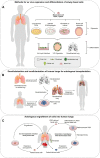Implications for Extracellular Matrix Interactions With Human Lung Basal Stem Cells in Lung Development, Disease, and Airway Modeling
- PMID: 34054525
- PMCID: PMC8149957
- DOI: 10.3389/fphar.2021.645858
Implications for Extracellular Matrix Interactions With Human Lung Basal Stem Cells in Lung Development, Disease, and Airway Modeling
Abstract
The extracellular matrix (ECM) is not simply a quiescent scaffold. This three-dimensional network of extracellular macromolecules provides structural, mechanical, and biochemical support for the cells of the lung. Throughout life, the ECM forms a critical component of the pulmonary stem cell niche. Basal cells (BCs), the primary stem cells of the airways capable of differentiating to all luminal cell types, reside in close proximity to the basolateral ECM. Studying BC-ECM interactions is important for the development of therapies for chronic lung diseases in which ECM alterations are accompanied by an apparent loss of the lung's regenerative capacity. The complexity and importance of the native ECM in the regulation of BCs is highlighted as we have yet to create an in vitro culture model that is capable of supporting the long-term expansion of multipotent BCs. The interactions between the pulmonary ECM and BCs are, therefore, a vital component for understanding the mechanisms regulating BC stemness during health and disease. If we are able to replicate these interactions in airway models, we could significantly improve our ability to maintain basal cell stemness ex vivo for use in in vitro models and with prospects for cellular therapies. Furthermore, successful, and sustained airway regeneration in an aged or diseased lung by small molecules, novel compounds or via cellular therapy will rely upon both manipulation of the airway stem cells and their immediate niche within the lung. This review will focus on the current understanding of how the pulmonary ECM regulates the basal stem cell function, how this relationship changes in chronic disease, and how replicating native conditions poses challenges for ex vivo cell culture.
Keywords: airway modeling; basal stem cells; cellular niche; chronic lung disease; extracellular matrix; regeneration.
Copyright © 2021 Busch, Lorenzana and Ryan.
Conflict of interest statement
The authors declare that the research was conducted in the absence of any commercial or financial relationships that could be construed as a potential conflict of interest.
Figures

Similar articles
-
Culture Conditions Differentially Regulate the Inflammatory Niche and Cellular Phenotype of Tracheo-Bronchial Basal Stem Cells.bioRxiv [Preprint]. 2024 Sep 5:2024.09.04.611264. doi: 10.1101/2024.09.04.611264. bioRxiv. 2024. Update in: Am J Physiol Lung Cell Mol Physiol. 2025 Apr 01;328(4):L538-L553. doi: 10.1152/ajplung.00293.2024. PMID: 39282256 Free PMC article. Updated. Preprint.
-
Extracellular matrix in lung development, homeostasis and disease.Matrix Biol. 2018 Nov;73:77-104. doi: 10.1016/j.matbio.2018.03.005. Epub 2018 Mar 8. Matrix Biol. 2018. PMID: 29524630 Free PMC article. Review.
-
A 3D Epithelial-Mesenchymal Co-Culture Model of the Airway Wall Using Native Lung Extracellular Matrix.Bioengineering (Basel). 2024 Sep 21;11(9):946. doi: 10.3390/bioengineering11090946. Bioengineering (Basel). 2024. PMID: 39329688 Free PMC article.
-
The interplay between extracellular matrix and progenitor/stem cells during wound healing: Opportunities and future directions.Acta Histochem. 2021 Oct;123(7):151785. doi: 10.1016/j.acthis.2021.151785. Epub 2021 Sep 6. Acta Histochem. 2021. PMID: 34500185 Review.
-
Generation of a Close-to-Native In Vitro System to Study Lung Cells-Extracellular Matrix Crosstalk.Tissue Eng Part C Methods. 2018 Jan;24(1):1-13. doi: 10.1089/ten.tec.2017.0283. Epub 2017 Oct 23. Tissue Eng Part C Methods. 2018. PMID: 28895470
Cited by
-
Airway basal stem cell therapy for lung diseases: an emerging regenerative medicine strategy.Stem Cell Res Ther. 2025 Jan 29;16(1):29. doi: 10.1186/s13287-025-04152-5. Stem Cell Res Ther. 2025. PMID: 39876014 Free PMC article. Review.
-
Culture conditions differentially regulate the inflammatory niche and cellular phenotype of tracheobronchial basal stem cells.Am J Physiol Lung Cell Mol Physiol. 2025 Apr 1;328(4):L538-L553. doi: 10.1152/ajplung.00293.2024. Epub 2025 Feb 21. Am J Physiol Lung Cell Mol Physiol. 2025. PMID: 39982813 Free PMC article.
-
An Introduction to Engineering and Modeling the Lung.Adv Exp Med Biol. 2023;1413:1-13. doi: 10.1007/978-3-031-26625-6_1. Adv Exp Med Biol. 2023. PMID: 37195523
-
Culture Conditions Differentially Regulate the Inflammatory Niche and Cellular Phenotype of Tracheo-Bronchial Basal Stem Cells.bioRxiv [Preprint]. 2024 Sep 5:2024.09.04.611264. doi: 10.1101/2024.09.04.611264. bioRxiv. 2024. Update in: Am J Physiol Lung Cell Mol Physiol. 2025 Apr 01;328(4):L538-L553. doi: 10.1152/ajplung.00293.2024. PMID: 39282256 Free PMC article. Updated. Preprint.
-
Development of a novel air-liquid interface airway tissue equivalent model for in vitro respiratory modeling studies.Sci Rep. 2023 Jun 22;13(1):10137. doi: 10.1038/s41598-023-36863-1. Sci Rep. 2023. PMID: 37349353 Free PMC article.
References
Publication types
Grants and funding
LinkOut - more resources
Full Text Sources
Other Literature Sources

